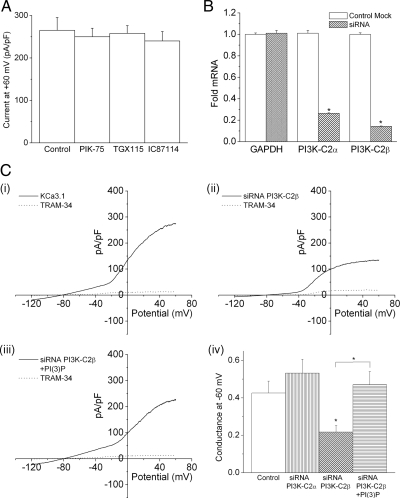Figure 1.
Silencing of PI3KC2β in CD4 T cells by siRNA leads to a decrease in KCa3.1 channel activity. (A) Purified human CD4 T lymphocytes were stimulated with antibodies to CD3 and CD28 for 48 h. Whole cell patch clamping was performed 48 h after stimulation with or without 1 μM of the class 1 PI3K inhibitors shown (Knight and Shokat, 2007). (B, C) Purified CD4 T lymphocytes were transfected with a pool of siRNAs to PI3K-C2α or PI3K-C2β mRNA (Dharmacon) using AMAXA reagents and, after resting overnight, were stimulated with antibodies to CD3 and CD28 for 48 h. Whole cell patch-clamping was performed 48 h after stimulation. (B) Real time PCR showing >80% silencing of PI3K-C2α and PI3K-C2β mRNA. *p < 0.05 as compared to control cells. (C) Whole cell patch-clamping showing the I–V plot of (i) control cells (ii) siRNA PI3K-C2β cells and (iii) siRNA PI3K-C2β cells with 100 nM PI(3)P in the pipette solution. (iv) Bar graph summary of KCa3.l conductance (pS) measured at −60 mV (N = 12–l5 cells). Also shown is 1) decreased expression of PI3K-C2α by siRNA does not affect KCa3.1 conductance and 2) dialyzing PI3K-C2β siRNA transfected cells with 100 nM PI(3)P rescue KCa3.l conductance. *p < 0.05 as compared to control KCa3.1 conductance and as indicated in the graph.

